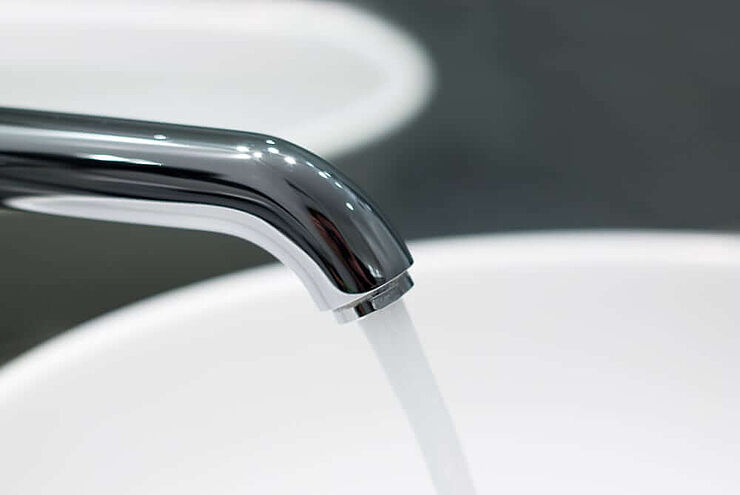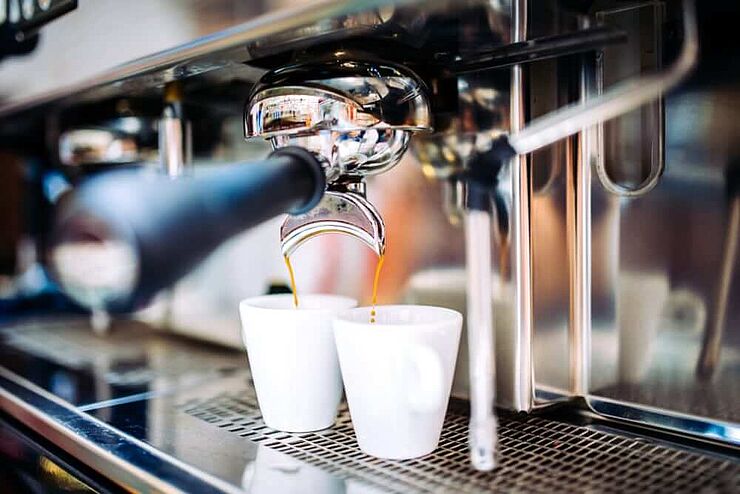
Sanitary
From lavatory to wellness shower – A. u. K. Mueller offers a modern and reliable solution for almost every sanitary application.

A solenoid valve from A. u. K. Müller contains more than 100 years of pioneering spirit and inventiveness. As early as 1951, we specialised in the development and manufacture of solenoid valves, at that time still preferably made of metallic materials. Since the seventies, we have increasingly focused on the development of plastic solenoid valves.
Since then, A. u. K. Müller solenoid valves have been used wherever fluids have to be controlled or regulated. There is hardly a day that goes by without coming into contact with products in which our high-quality valves are installed. Be it in the morning when you take a shower, during your coffee break, at work or when you wash your hands, because we produce for sanitary, vending, medical technology, agricultural and food technology, as well as for environmental technology and industry.
A. u. K. Müller stands for competence in valve technology. That is why we would like to give you answers to the following questions:

From lavatory to wellness shower – A. u. K. Mueller offers a modern and reliable solution for almost every sanitary application.

From laundry to commercial dishwasher – Diversified valve technology for industrial applications


Food processing is a highly sensitive field. A. u. K. Mueller products have advantages here.

Medical products are subject to strict specifications. A. u. K. Mueller fulfills these requirements and delivers high-quality products for hemodialysis devices as well as for disinfection and sterilization applications

Sustainable building technology – with products from A. u. K. Mueller
A solenoid valve (or electromagnetic valve) is a component for shutting off or controlling liquids or gases (medium) which is actuated by an electromagnet. This enables the automated control of media by means of electronics.
Solenoid valves are the most frequently used control and regulating elements in fluid technology and pneumatics. Their task is to shut off, transfer, meter, distribute or mix media. They can therefore be found in a wide variety of applications. Our solenoid valves are therefore also used in a wide range of applications, such as in medicine, milking systems, beverage vending machines, sanitary facilities or environmental technology.
Various requirements are placed on solenoid valves, the different emphases of which depend on the respective application:
To activate a valve function, a force is always required with which the valve opens, closes or brings the media paths into an intermediate position. This force is generated by actuators, for example motors, floats, the media compressed air or vacuum as well as electromagnets. The electromagnet is the actuator most commonly used at A. u. K. Müller.
Solenoid valves belong to the class of electrodynamically operated valves that actuate the valve actuator via an electromagnet by stroke work. This stroke work acts directly or indirectly on an elastomer sealing element via which the valve seat is opened or closed.
Valve types are usually differentiated according to the following main criteria: the control type, the function and the number of media paths.
The electromagnet or the magnetic field it generates attracts the core with seal, which directly causes the valve to open and close from 0 bar. A pressure difference between the valve inlet and outlet is not required. Directly controlled solenoid valves are particularly suitable for low pressures and are characterised by high switching speeds.
The opening and closing of the valve is initiated by the solenoid and essentially carried out by the medium pressure.
The diaphragm installed in the valve has the task of sealing the medium flow via the valve seat on the one hand, and on the other hand it fulfils the sealing function between the valve housing and the bonnet.
The diaphragm has two holes, the so-called mounting and dismounting hole. The build-up bore ensures that the pressure over the diaphragm is equal to the pressure at the valve inlet. As with the direct-acting valve, a magnetic field is generated by means of an electromagnet, which attracts the core and thus opens the extraction hole in the diaphragm. This causes medium to flow through the extraction hole into the outlet, which causes the pressure above the diaphragm to drop. This in turn causes the pressure below the membrane, which corresponds to the inlet pressure, to be greater than the pressure above the membrane. This causes the diaphragm to be pushed upwards by the inlet pressure and the valve seat is released.
In contrast to directly controlled valves, valves of this control type always require a pressure difference between the valve inlet and outlet.
Forced lift valves are a combination of a direct operated and servo solenoid valve. The difference is that, unlike the servo solenoid valve, the core is connected to the diaphragm in the forced lift. Therefore, the diaphragm is actively lifted by the core in the opening process. As with the servo valve, the medium pressure or inlet pressure also supports here.
The great advantage of this type of control is that no differential pressure is required to open the valve. Therefore, these valves already switch safely from 0 bar.
A vacuum applied above the diaphragm causes it to be lifted and the valve seat to be released. At A. u. K. Müller, these valves are directly controlled, which means that no differential pressure is required and the valves switch safely from 0 bar.
In the de-energised state, the valve is closed (NC valves = normally closed) or open (NO valves = normally open). To maintain the other operating state in each case, the current flow must also be maintained.
In the de-energised state, the valve remains in a stable end position. Only a short impulse switches the valve to the other end position. The advantage lies in the extremely low power consumption, which also makes battery operation possible for years. Often the self-discharge of the battery is higher than the energy consumption due to the switching pulses.
The valve can be opened or closed continuously like a water tap and held stably in any desired intermediate position.
Do you have any questions? Write to us!
Various combinations of the features listed above are possible. Thus, the selection of the right valve for your requirements also depends on many factors, such as:
Thus, choosing the right product for your project becomes a complex design task in which we will be happy to assist you. Our technical sales team looks forward to receiving your non-binding project enquiry! Simply write to us using our contact form or call us on 0211 7391-0. We will be happy to assist you! Please note that we unfortunately cannot accept enquiries for individual replacement valves because, as a manufacturer, we only produce in series.

A. u. K. Müller GmbH & Co. KG
Dresdener Straße 162
D - 40595 Düsseldorf
Telefon: +49 211 73 91-0
Telefax: +49 211 73 91-281
E-Mail: info(at)akmueller.de
A.K. Muller (UK) Ltd.
Unit 4, Brookside Business Park
Brookside Avenue, Rustington
GB - West Sussex BN16 3LP
Tel: +44 1903 788 888
Fax:+44 1903 785 817
E-Mail: valves(at)akmuller.co.uk
A.K. Müller France
10 Avenue du Gué Langlois
Z.A.E du Gué Langlois
F-77600 Bussy Saint Martin
Telefon: +33 1 64 62 95 14
Telefax: +33 1 64 62 95 12
E-Mail: info(at)akmuller.fr
A. u. K. Müller Shanghai
Rm26D, Huadu Mansion,
Zhangyang Rd. 838,
Shanghai, 200122, China
Telefon: +86 21 58 20 40 80
Telefax: +86 21 58 20 42 12
E-Mail: info(at)akmueller.de